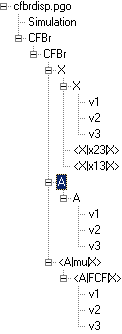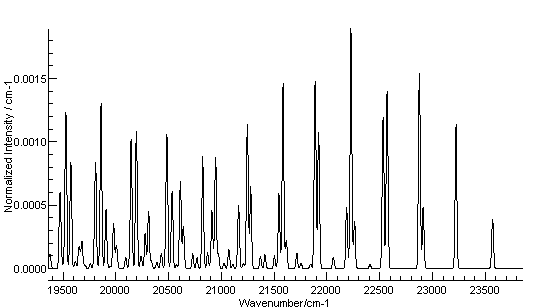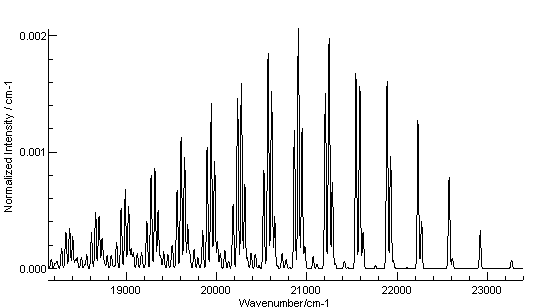 The data file
simulates the vibrational structure of the dispersed
fluorescence spectrum obtained by exciting v2 = 1 in
the A state of CFBr. (See Rotational
Structure of the A-X electronic transition in CFBr for the rotational
structure.) The data file is a reasonably straightforward
example of simulating vibrational structure. Notes:
The data file
simulates the vibrational structure of the dispersed
fluorescence spectrum obtained by exciting v2 = 1 in
the A state of CFBr. (See Rotational
Structure of the A-X electronic transition in CFBr for the rotational
structure.) The data file is a reasonably straightforward
example of simulating vibrational structure. Notes:
- The 79Br/81Br isotope splitting was
not resolved in the dispersed fluorescence spectrum, so the
set-up is for the average of the two.
- The x13
and x23
terms in the ground state must be included using perturbations.
- The vibrational mode displacements were determined by
empirical fitting, so no information about the nuclei have
been entered.
- A dispersed fluorescence rather than an absorption spectrum
is simulated by setting Initial to
false for the ground state manifold (X) and true for the upper
state manifold (A).
This file also provides an example of using a
Non-Boltzmann Population to simulate
fluorescence from v
2 = 1 rather than v
2 = 0
that a Boltzmann population would imply. This was set up by:
- Use "View","States"
to bring up the State Details Window.
- Select the A state in the Active Object combo
box at the top of the window.
- Right click on the required state in the "Eigenvalues" pane
(the lower matrix), here state number 2 "0,1,0", and select
"Add to population selection".
- The required population is now a parameter in the A state manifold object.
- To use the manually entered populations rather than a
Boltzmann population, set the temperature negative.
Note that a similar effect can be obtained using vMin and vMax for various
modes, though an implementation restriction in the current
version means that values of vMin
> 0 are likely to slow calculations for intensities
considerably.
Dispersed fluorescence spectrum from v
2 = 1:
Dispersersed fluorescence spectrum from the origin band, obtained by
setting T = 300: The data file
simulates the vibrational structure of the dispersed
fluorescence spectrum obtained by exciting v2 = 1 in
the A state of CFBr. (See Rotational
Structure of the A-X electronic transition in CFBr for the rotational
structure.) The data file is a reasonably straightforward
example of simulating vibrational structure. Notes:
The data file
simulates the vibrational structure of the dispersed
fluorescence spectrum obtained by exciting v2 = 1 in
the A state of CFBr. (See Rotational
Structure of the A-X electronic transition in CFBr for the rotational
structure.) The data file is a reasonably straightforward
example of simulating vibrational structure. Notes:
